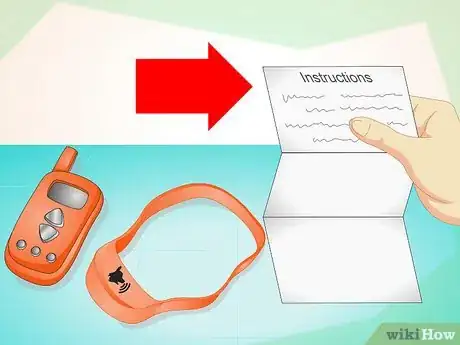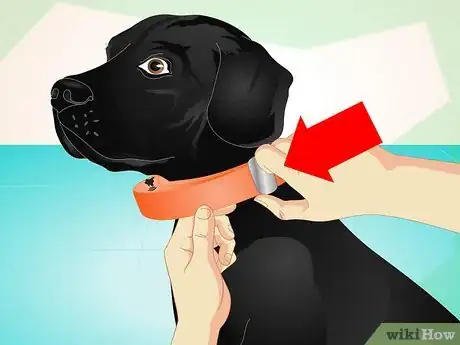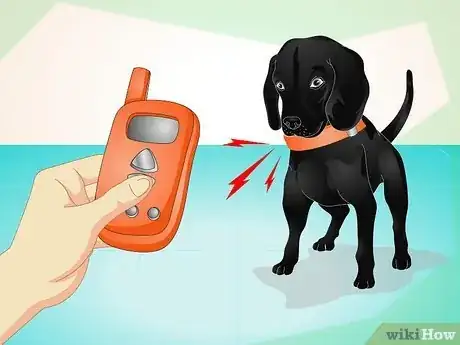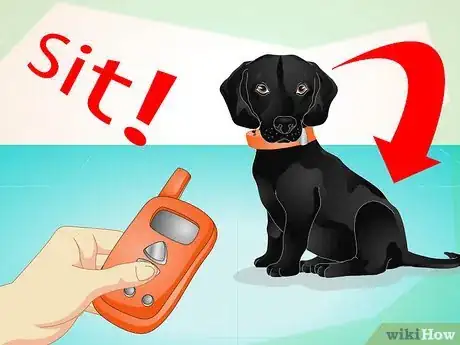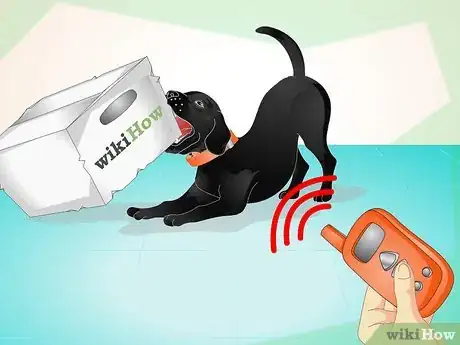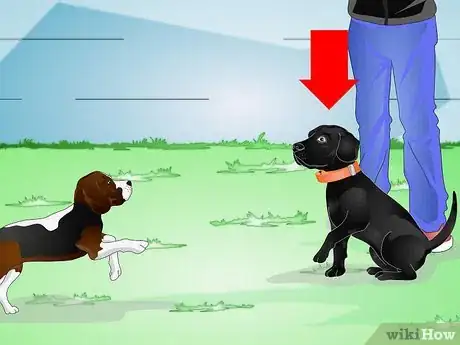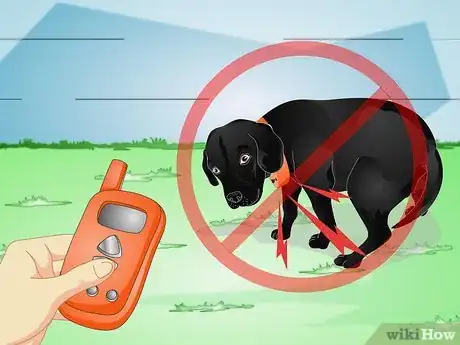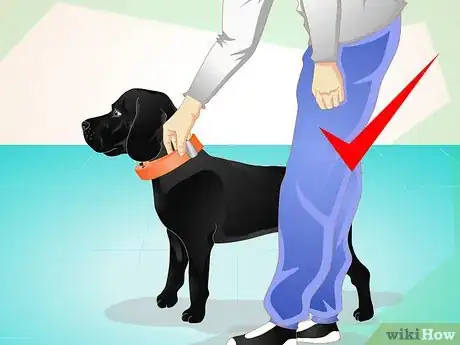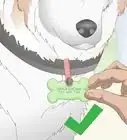This article was co-authored by Dominik Feichtner. Dominik Feichtner is a Professional Dog Trainer and Behaviorist and the Owner of The Dog Behaviorist NYC out of New York, New York. With over eight years of experience working with dogs, Dominik specializes in general obedience, behavior modification, and puppy training. His commitment to a balanced, common-sense approach led to his recognition as one of the “Best Dog Trainers in Brooklyn” and one of the “Best Dog Trainers in NYC” by Pooch and Harmony in 2020.
There are 9 references cited in this article, which can be found at the bottom of the page.
wikiHow marks an article as reader-approved once it receives enough positive feedback. This article received 13 testimonials and 94% of readers who voted found it helpful, earning it our reader-approved status.
This article has been viewed 278,439 times.
An electronic remote training collar is a device that applies electric current to a dog's neck to give them a signal. It is wireless, powered by batteries, and usually comes with a transmitter that sends a signal to the collar. This shock the collar applies is intended to give the dog a mild stimulus, similar to what you experience when you receive a static shock. When given while the dog is doing undesirable behaviors, the shock is meant to deter the activity in the future. Electronic remote training collars allow you to train your dog with positive punishment from a distance and give you the ability to train your dog even when it can't actually see or hear your commands.
Steps
Using an Electronic Remote Training Collar
-
1Read the instructions that come with the collar. Do this before you put it on your dog. There are many different kinds of electronic remote training collars available and you need to know how to operate the collar before trying it on your dog.
-
2Put the batteries in the collar and in the transmitter. Make sure both function before you put them on your dog. Also, make sure that the system is turned off and set to the lowest setting before attaching it to a dog. This will assure that you don't shock the dog on accident.Advertisement
-
3Attach the collar to your dog's neck. Some collars have small prongs that need to touch the skin of the dog, but you don't want them to cause discomfort. Make sure that the collar is tight enough that it won't fall off and that the prongs touch the dog's neck, but don't make it so tight that it is uncomfortable for the dog or restricts its breathing.
-
4Have the collar on your dog for a week before turning it on.[1] [2] Do not use the collar right away. Instead, let your dog get used to it. This way, the dog will associate the collar with good times and fun, instead of punishment.
- The goal behind using an electronic collar is to make the dog think that the negative behavior you are trying to stop is causing the shock, not the collar. If you put the collar on the dog and immediately start shocking it, the dog may quickly figure out that the problem is with the collar.[3]
-
5Begin using your electronic remote training collar. Start at the lowest level of stimulation and observe your dog when you activate it. The dog's ear might twitch or it may move its head as if trying to get away from the collar.
- If your dog doesn't respond at the lowest stimulation, slowly turn the transmitter to the next level and try again.
-
6Reinforce commands your dog understands. When you train your dog with an electronic collar, begin with commands the dog is familiar with. Say the command, such as sit or stay, and wait for your dog to respond. If your dog is not paying attention, press the button on your transmitter and repeat the command.
- Set the transmitter to the lowest level of stimulation your dog reacts to. When you use an electronic collar, you want to train your dog, not hurt him.
- Praise your dog as soon as it responds. Reward it with a pat, by saying "good dog," or with a special treat. When you train dogs, you want to reinforce their good behavior with a reward.
-
7Control bad behavior. You may use an electronic collar to manage annoying or aggressive behavior. For instance, if your dog digs holes in the backyard whenever you let him outside, be ready to use an electronic collar to train him when you let him out. When the dog begins to dig, or engage in whatever behavior you want to control, activate the transmitter. Do not hold the button down for more than 3 seconds and do not punch it repeatedly. The object is to train your dog, not injure him.
- Don't let your dog see you. You don't want your dog to know you are causing the unpleasant sensation around its neck when it starts digging. Rather, you want your dog to associate the sensation with bad behavior.
Understanding the Debates About Electronic Collars
-
1Understand arguments in favor of using electronic collars. Advocates for the use of electronic collars state that the collars give a small electrical shock, similar to a shock from static build-up, that does not hurt the dog.[4] They also argue that these collars can actually give dogs quite a bit of freedom, as you will have a way to control your dog when it is off leash.[5]
- There is some debate among those that use electronic collars about what the collars should be used for. Some argue that the collars should only be used on dogs that have severe behavior problems, for instance, to change behavior that could get a dog put down. There are others that use the collars for correcting behavior, such as if a dog gets into a garden bed the owner will turn on the collar to teach the dog that this behavior is bad. There are others still that use the collar to signal a dog to do positive behaviors, such as sitting, staying, or lying down.[6]
-
2Understand arguments against using electronic collars. Those opposed to the use of these collars state that there is a great chance of misuse and abuse when using a shock collar.[7] In addition, opponents argue that other training systems, such as simple positive reinforcement of behavior, can be just as effective.[8] While positive reinforcement makes the training about the dog's choice of behavior, positive punishment with a shock collar forces a dog to choose between pain and behavior.
-
3Decide if using an electronic collar on your dog is right for you and your dog. Make the decision for yourself whether you think an electronic collar will help your dog learn what they shouldn't do. If you do decide to use it, make sure to follow the manufactures instructions and use the collar properly, not as punishment but to reinforce behavior.
- If you plan on using an electric collar, hire a professional trainer to help you out.[9]
Expert Q&A
-
QuestionHow much do electric dog training collars cost?
 Dominik FeichtnerDominik Feichtner is a Professional Dog Trainer and Behaviorist and the Owner of The Dog Behaviorist NYC out of New York, New York. With over eight years of experience working with dogs, Dominik specializes in general obedience, behavior modification, and puppy training. His commitment to a balanced, common-sense approach led to his recognition as one of the “Best Dog Trainers in Brooklyn” and one of the “Best Dog Trainers in NYC” by Pooch and Harmony in 2020.
Dominik FeichtnerDominik Feichtner is a Professional Dog Trainer and Behaviorist and the Owner of The Dog Behaviorist NYC out of New York, New York. With over eight years of experience working with dogs, Dominik specializes in general obedience, behavior modification, and puppy training. His commitment to a balanced, common-sense approach led to his recognition as one of the “Best Dog Trainers in Brooklyn” and one of the “Best Dog Trainers in NYC” by Pooch and Harmony in 2020.
Dog Trainer & Behaviorist They can be pretty expensive. A good electric dog training collar can cost you upwards of $180.
They can be pretty expensive. A good electric dog training collar can cost you upwards of $180. -
QuestionAre electric training collars for dogs cruel?
 Dominik FeichtnerDominik Feichtner is a Professional Dog Trainer and Behaviorist and the Owner of The Dog Behaviorist NYC out of New York, New York. With over eight years of experience working with dogs, Dominik specializes in general obedience, behavior modification, and puppy training. His commitment to a balanced, common-sense approach led to his recognition as one of the “Best Dog Trainers in Brooklyn” and one of the “Best Dog Trainers in NYC” by Pooch and Harmony in 2020.
Dominik FeichtnerDominik Feichtner is a Professional Dog Trainer and Behaviorist and the Owner of The Dog Behaviorist NYC out of New York, New York. With over eight years of experience working with dogs, Dominik specializes in general obedience, behavior modification, and puppy training. His commitment to a balanced, common-sense approach led to his recognition as one of the “Best Dog Trainers in Brooklyn” and one of the “Best Dog Trainers in NYC” by Pooch and Harmony in 2020.
Dog Trainer & Behaviorist No, they're not designed to be. A remote collar will not hurt, traumatize, or scare your dog if taught to them properly.
No, they're not designed to be. A remote collar will not hurt, traumatize, or scare your dog if taught to them properly. -
QuestionWhat is the best way to use a shock collar?
 Dominik FeichtnerDominik Feichtner is a Professional Dog Trainer and Behaviorist and the Owner of The Dog Behaviorist NYC out of New York, New York. With over eight years of experience working with dogs, Dominik specializes in general obedience, behavior modification, and puppy training. His commitment to a balanced, common-sense approach led to his recognition as one of the “Best Dog Trainers in Brooklyn” and one of the “Best Dog Trainers in NYC” by Pooch and Harmony in 2020.
Dominik FeichtnerDominik Feichtner is a Professional Dog Trainer and Behaviorist and the Owner of The Dog Behaviorist NYC out of New York, New York. With over eight years of experience working with dogs, Dominik specializes in general obedience, behavior modification, and puppy training. His commitment to a balanced, common-sense approach led to his recognition as one of the “Best Dog Trainers in Brooklyn” and one of the “Best Dog Trainers in NYC” by Pooch and Harmony in 2020.
Dog Trainer & Behaviorist Only use a shock collar if you have a professional trainer show you how to properly use it.
Only use a shock collar if you have a professional trainer show you how to properly use it.
Warnings
- There are people who feel you should NEVER use an electric collar or shock collar to train your dog.⧼thumbs_response⧽
References
- ↑ https://youtu.be/I-2skCQZKno?t=72
- ↑ https://www.youtube.com/watch?v=I-2skCQZKno
- ↑ https://www.youtube.com/watch?v=TYNmB9ZOr5k
- ↑ http://www4.uwsp.edu/psych/dog/la/castle3.htm
- ↑ http://www.drsfostersmith.com/pic/article.cfm?aid=161
- ↑ http://animals.io9.com/the-science-of-dog-training-is-it-okay-to-use-a-shock-1632740695#
- ↑ http://www.humanesociety.org/animals/dogs/tips/collars.html
- ↑ http://animals.io9.com/the-science-of-dog-training-is-it-okay-to-use-a-shock-1632740695#
- ↑ Dominik Feichtner. Dog Trainer & Behaviorist. Expert Interview. 18 March 2021
About This Article
To use an electronic dog training collar, start by having your dog wear it for a week with the power off so it will get used to the collar. Then, start at the lowest level of stimulation and observe your dog’s reaction. If there’s no response, slowly turn it to the next level until you see your dog’s ear twitch, or it shows mild discomfort. After that, begin with commands your dog is familiar with. If your dog isn’t paying attention, press the button and repeat the command. Once your dog responds to the command, reward it with a treat to reinforce the positive behavior. For more tips, like how to decide if an electronic collar is right for your dog, read on!
